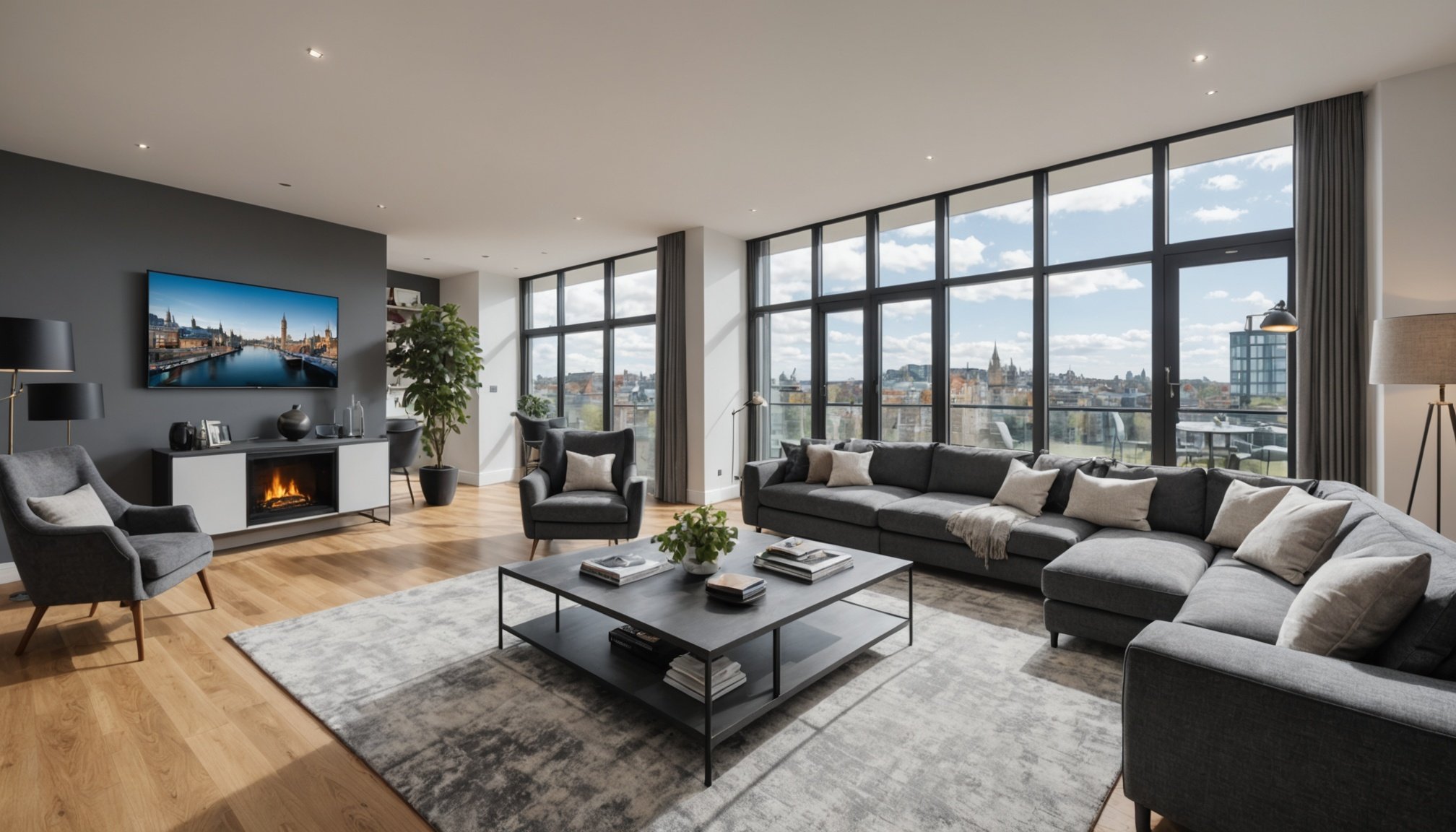Transforming UK Real Estate: Enhancing Property Purchases Through Immersive Virtual Tours
In the ever-evolving landscape of the UK real estate market, technology has been a driving force behind innovation and efficiency. One of the most significant advancements in recent years is the integration of virtual tours, which have revolutionized the way properties are showcased and purchased. Here, we delve into the world of virtual tours, exploring their benefits, types, and how they are transforming the real estate industry.
Understanding Virtual Tours in Real Estate
Virtual tours have become a cornerstone of real estate technology, offering an immersive experience that enhances client engagement and simplifies the property viewing process. These digital simulations allow potential buyers to explore different rooms and spaces of a property at their convenience, regardless of their geographic location.
In parallel : Revamping city travel: leveraging big data to transform public transportation in uk urban areas
Overview and Importance
Virtual tours are more than just a collection of images or videos; they provide a comprehensive and interactive way for buyers to explore properties. This method has become a staple in the UK real estate scene, offering a layer of accessibility and efficiency that was previously unimaginable. For real estate agencies, virtual tours attract more eyes and engage potential buyers in a more profound manner than traditional listings[1].
Benefits of Virtual Tours
The benefits of virtual tours are multifaceted and far-reaching, making them an indispensable tool for estate agents and buyers alike.
Also to read : Unwind in paradise: top vacation rentals in st barts
24/7 Open House
Virtual tours offer a 24/7 open house experience, enabling client engagement regardless of time or location. This feature is particularly beneficial for international buyers or those with busy schedules, allowing them to make informed decisions without the need for physical viewings[1].
Time and Cost Efficiency
Virtual tours save time for both buyers and realtors by pre-qualifying interested clients. They reduce the number of unnecessary physical viewings, which can be time-consuming and costly. For example, using virtual tours, agents can avoid the hassle of multiple showrounds and focus more on converting qualified leads into sales[2].
Enhanced Decision Making
Virtual tours provide detailed property insights that plain images or descriptions cannot. This immersive experience helps buyers make more informed decisions, as they can explore every nook and cranny of the property from the comfort of their screens. According to GO Virtual Tours, “90% of buyers would be more compelled by a listing with a 3D tour,” highlighting the significant impact on decision making[2].
Types and Features of Virtual Tours
The real estate industry utilizes several types of virtual tours, each with unique features tailored to enhance the viewing experience.
Interactive 3D Walkthroughs
Interactive 3D walkthroughs allow users to navigate properties freely, providing a highly immersive experience. Platforms like Matterport and Cupix offer these features, enabling buyers to explore properties in a highly interactive and engaging manner[1].
Guided Video Tours
Guided video tours provide an informative narrative, often led by a real estate agent or property owner. These tours offer a more personalized experience, highlighting key features and answering potential questions that buyers might have[1].
Multimedia MatterTags
Matterport’s Multimedia MatterTags are another innovative feature, allowing agents to add text, images, links, and videos to the tour. This feature can link to brochures, menus, or additional information, enhancing the overall viewing experience and providing buyers with more detailed insights into the property[2].
Selecting the Right Technology for Virtual Tours
Choosing the correct virtual tour software is crucial for creating a compelling and engaging immersive experience.
Key Features to Look For
Real estate agents should prioritize software with high-resolution imagery, seamless navigation, and interactive elements. Platforms that offer integration with 3D modeling or VR headsets can amplify the immersive experience. Additionally, analytics to track user interactions can provide vital feedback on engagement levels[1].
Popular Virtual Tour Platforms
Here is a comparison of some popular virtual tour platforms:
| Platform | Key Features | Pricing |
|---|---|---|
| Matterport | 3D modeling, VR headset compatibility, multimedia MatterTags | Part of property marketing packages or individual subscriptions |
| GotoView | Combines 3D showcase with video call facilitation | Custom pricing based on services required |
| MadeSnappy360 | Easy-to-use, 360-degree camera, mobile app integration | £49 per month with a money-back guarantee |
| Tour Wizard | User-friendly, panoramic photos transformation, online in 15 minutes | £24-£50 per month, pay-per-tour option |
| Floorfy | 360-degree photos, annual subscription with free camera | Varies based on active tours and agents |
| Pano2VR | Interactive virtual tours, hotspots, multimedia, VR support | Custom pricing based on features required |
Each platform has its unique strengths and can be chosen based on the specific needs and preferences of the real estate agency[3].
Step-by-Step Guide to Implementing Virtual Tours
Creating an engaging and effective virtual tour requires careful planning and execution.
Initial Setup and Planning
Before diving into production, assess the property to determine the essentials for virtual tour implementation. Plan the layout by mapping out the property’s flow, deciding the sequence in which rooms will appear, and outlining any additional content such as voiceovers or virtual walkthroughs. Establishing a clear timeline will help manage the production process, ensuring timely delivery without compromising quality[1].
Producing High-Quality Virtual Tours
Capturing high-resolution images and videos is pivotal for a successful tour. Utilize techniques that enhance lighting and angles, showcasing the property in its best light. Staging is equally important; keeping homes tidy, decluttered, and aesthetically pleasing can dramatically impact the tour’s perception. After capturing the content, invest time in editing and refining to guarantee a professional look[1].
Publishing and Promoting Virtual Tours
Once the virtual tour is ready, select strategic platforms for hosting. Real estate websites and social media channels can significantly boost its reach. Email marketing can target potential buyers, enhancing visibility. Employ analytics to track user engagement, refine future tours, and ultimately maximize the effectiveness of your virtual tour content.
Leveraging Virtual Tours in Marketing
Virtual tours are not just a tool for viewing properties; they are a powerful marketing strategy.
Attracting Qualified Prospects
Virtual tours attract more qualified prospects by giving viewers the most complete representation of the property. This filters out those the property may not be right for while attracting leads that are genuinely interested. For instance, Redfin saw a 600% increase in virtual walkthroughs since the beginning of the COVID-19 pandemic, highlighting the effectiveness of this approach[2].
Enhancing Property Listings
Including virtual tours in property listings can significantly enhance their appeal. Here are some ways to make the best listing presentations:
- Sell at a Higher Price: Properties with 3D virtual tours can sell at a 4-9% higher sales price.
- Reduce Time on Market: Virtual tours can decrease the time on market by up to 31%.
- Increase Engagement: 90% of buyers would be more compelled by a listing with a 3D tour[2].
Utilizing Social Media and SEO
Virtual tours can be embedded on real estate websites and shared on social media platforms to increase visibility. Focusing on keywords that potential clients search for can also improve SEO. Incorporating client feedback and reviews can demonstrate the value of virtual tours and attract more potential buyers[1].
The Future of Real Estate: Integrating Augmented and Virtual Reality
As technology progresses, the integration of augmented reality (AR) and virtual reality (VR) is becoming more prevalent in the real estate industry.
Augmented Reality in Real Estate
AR can enhance property tours by providing additional information about the property and its surroundings. For example, AR can link to local services, restaurants, and attractions, giving buyers a more comprehensive view of the area[2].
Virtual Reality Experiences
VR headsets offer a fully immersive experience, allowing buyers to explore properties in a highly interactive and engaging manner. Companies like View360Degrees specialize in creating these immersive experiences, combining VR videos, 360 virtual tours, and 3D modeling to showcase properties in a lifelike way[4].
Practical Insights and Actionable Advice
For estate agents looking to integrate virtual tours into their marketing strategy, here are some practical insights and actionable advice:
- Invest in High-Quality Equipment: Use high-resolution cameras and ensure proper lighting and staging to capture the best possible images and videos.
- Choose the Right Software: Select software that offers the features you need, such as interactive elements, multimedia integration, and analytics.
- Promote Effectively: Use social media, email marketing, and SEO to maximize the reach of your virtual tours.
- Monitor and Adjust: Use analytics to track user engagement and adjust your strategy accordingly to improve future tours.
Virtual tours have transformed the UK real estate market by providing an immersive and interactive way for buyers to explore properties. With their ability to offer 24/7 open house experiences, reduce time and costs, and enhance decision making, virtual tours are here to stay. As technology continues to evolve, integrating AR and VR will further enhance the property viewing experience, making it more engaging and informative for potential buyers.
In the words of Anuj Kharbanda from View360Degrees, “Immersive AR and VR experiences are not just the future; they are the present. They offer a lifelike way to showcase properties, enhancing the overall buying experience and setting new standards in real estate marketing”[4].
By embracing these technologies and strategies, estate agents can not only stay ahead in the competitive real estate market but also provide a superior experience for their clients, ultimately leading to more successful property purchases.







